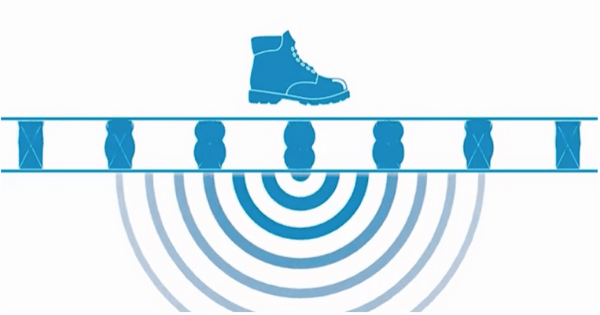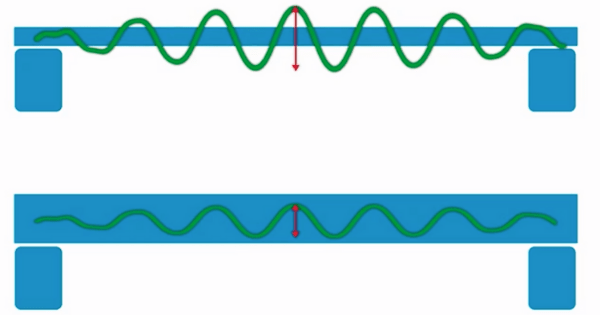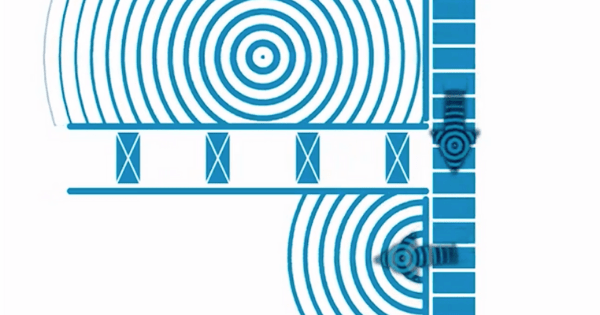Impact and Airborne Sound Solutions for Floors - A Proctor Group
Please contact us via contact@construction-cpd.com to get permission to publish this video on your website.
<div style="position: relative!important; width: 100%!important; min-height: 700px; overflow: hidden!important; padding-top: 56.25%!important;"><iframe src="https://www.construction-cpd.com/cpd-external-view?ExternalId=39&ReturnUrl=https://www.construction-cpd.com/sound-reduction-for-floors-cpd" style="position: absolute; top: 0; left: 0; bottom: 0; right: 0; width: 100%; height: 100%; min-height: 500px; border: none;" mozallowfullscreen webkitallowfullscreen allowfullscreen></iframe></div>
Introduction
Welcome to our Impact and Airborne Sound Solutions for Floors Webinar.
Hello and welcome to our webinar on acoustic floor systems. Today we’re going to look at how sound transfer in building works, and what regulations are applicable across the UK. We’ll finish up by taking a look at our range of flooring systems designed to reduce the impact of noise on building occupants.
Login to record your CPD points

Its estimated that up to a third of UK households experience noise related problems, with a third of these related directly to noise from neighbours.
As well as an increase in living density and more construction of flatted developments, widespread use of home cinema systems and hi-if equipment has contributed to driving this rise. Design trend such as laminate floors or stripping carpets to expose floorboards have also added to the problems.
Before we consider how to address these problems, lets begin by looking at some of the terminology used, and how this relates to buildings.
There are two type of sound we are concerned with when designing buildings, airborne sound and impact sound.
Airborne Sound

Airborne sound typically originates from sources like TVs, Home Cinema and stereo systems. Human voices are also a source of airborne sound, but it’s generally bass frequencies from entertainment systems that create the most issues as these are the most difficult sounds to restrict.
This type of sound is caused by the source vibrating the air to create sound waves. When these waves strike the walls, roof or floors of a building, they are converted into vibrations in the structure, which then transfers the sound around the building. This sound is then re-emitted by other surfaces, in the same way as a speaker generates sounds.
Airborne sound can come from outside the building as well as within, and typically travels in all directions throughout the structure. Building regulation therefore require most building elements to have some degree of airborne sound resistance built in.
Impact Sound

Impact sound occurs when mechanical impacts cause vibrations in the structure directly rather than via an external sound wave.
Impact sound comes primarily from footsteps, and it’s here that bare floorboards or laminate flooring cause problems as carpets and underlay contribute a lot to reducing these impacts.
As with airborne sound, these vibrations pass throughout the structure before being re-emitted in other areas. Unlike airborne sound though, the regulations regarding impact sound are typically only concerned with sound transmission between the floors of a building.
We’ll now take a look at some of the properties of walls and floors that can affect the sound transmission within buildings. A thorough understanding of these factors is important when designing structures to perform well acoustically.
Mass
When considering acoustics, the mass of a wall or floor is a very important factor. The heavier the element is, the harder it is for incoming vibrations to induce any vibrations. This has the effect of reflecting a greater proportion of the incident sound waves, resulting in less sound being transferred into the structure.
Heavy elements such as brick walls or concrete floor slabs are therefore better able to restrict the passage of sound (particularly those problematic low frequencies) than lighter timber frame structures. It is however not always practical or economically viable to use high mass constructions. This is particularly true in refurbishment projects where increasing the mass is often impossible.
Stiffness
The stiffness of the structure is important as it dictates the ability of the structure to vibrate. While the mass of an element restricts the absorption of sound waves, the stiffness restricts their transfer once absorbed.
The property governing this is the modulus of the element, in other words the ratio of depth to length.

A shallow and wide beam will vibrate more than a deep and narrow one, allowing for a greater amplitude of vibration and therefore more sound to be transferred. A related property here is resonance. Every part of the structure will have a frequency at which it vibrates more readily, this is the natural or resonant frequency. If the natural frequency of, for example a wall, coincides with a frequency in the incident sound, the effect may be to amplify rather than reduce the sound. Careful consideration of the stiffness and frequency response is therefore necessary to avoid this.
Isolation
An effective way to prevent sound transmission through structures is by physically isolating one side from the other. This can be achieved either by using entirely separate structural elements, such as independent floor and ceiling joists, or by using resilient mountings for floor and ceiling surfaces.
This approach aims to break the pathway for sound to travel through the structure from one side to the other. With independent structures there is an actual discontinuity in the pathway, leading to the best acoustic performance, however this approach results in very thick wall or floor elements so is not always practical, and as such tends to be used only when acoustic performance is the primary concern, such as in recording studios.
Resilient layers are usually a cheaper, thinner and lighter weight solution. They can be applied in the form of floor deck or batten systems, as ceiling mounting bars, or commonly both. These work similarly to car suspension, by damping the vibrations and reducing the energy from the sound waves by allowing a degree of movement. These systems must be carefully matched to the loadings expected on floors, as heavy weights can damage the layer, and reduce their effectiveness.
Absorbency
Absorbent acoustic materials work by reducing the echoes within cavities in a wall or floor construction. This has the effect of breaking up the sound waves in these spaces. This reduces the overall energy transfer by converting the energy in the sound waves into heat due to friction between adjacent fibres. Fibrous material such as mineral or polyester quilts are usually used for this purpose, most commonly in timber or steel framed structures. If there are voids present, partially filling them with an absorbent material will generally help reduce the sound transfer.
Flanking
Flanking transmission occurs when sound can pass around the sides of an element, for example bypassing a floor construction by passing through the walls instead. This can result in elements with well designed and specified acoustic insulation failing to perform as well as intended.
Flanking transmission can be minimised by paying attention to how linkages between floors and the supporting walls are designed, however outside of new build constructions this can be difficult to achieve. It’s therefore not uncommon in refurbishment projects to over specify the acoustic insulation to account for the unknown quantity of flanking transmission.

Acoustic floating floor systems will typically use a strip of foam at all perimeters to prevent physical contact between the “walked on” surface and the surrounding structure.
Building Regulations
The building regulation for acoustics have remained relatively stable since the mid 2000’s. The precise details vary across the UK, with slightly different variations used in England, Wales, Scotland and Northern Ireland but there is a lot in common, which we will consider here.
The regulations set requirements for Impact and/or Airborne sound transmission across separating walls between adjacent properties, and for airborne sound only within a single dwelling.
Between dwellings, floors are required to resist both impact and airborne sound, and walls to resist only airborne sound.
Between dwellings and commercial properties such as shops or offices only airborne sound insulation is required.
Where a roof terrace or balcony is over a dwelling, impact sound insulation is required.
These requirements are expressed by way of a “single figure value” which combines the sound levels across the full spectrum of frequencies into a single number. Depending on the regional variations across the UK this can be weighted to emphasise different frequencies or make the requirement more or less stringent.
In general though, acoustic requirements are expressed in terms of decibels (DB) of reduction in sound pressure. For airborne sound, this is expressed as DB, DnTw, with a higher single figure value indicating better acoustic performance. For impact sound, DB LnTw is used, with a lower number indicating better performance.

The requirements are reduced slightly for refurbishment and conversion projects, to reflect the practicalities of introducing acoustic insulation into existing structure. This can include period features that are listed, or unknown existing details or defects that cannot be easily remedied.
These single figure values do not vary linearly with perceived loudness. A change of 10DB in the acoustic performance equates to a doubling or halving of the perceived loudness. This makes the scale used very sensitive, but also makes it very difficult for the human ear to detect subtle variations in acoustic performance.
Testing and Compliance
Because of the difficulty in accurate perception by the human ear, an important aspect of the regulations is a mechanism to ensure compliance. Again the specifics of this differ between the various part of the UK, but pre-completion testing of at least some proportion of separating walls and floors features across the country. Acoustic testing is a complex process, and should only be undertaken by those appropriately accredited by organisations such as the United Kingdom Accreditation Service (UKAS) or registered with the Association of Noise Consultants.
Testing for airborne sound is typically done by using an omnidirectional speaker to play a pre-defined pattern of noise which can be measured by sensitive microphones and sound meters in adjacent rooms. The figure quoted is the difference in sound levels across the partition, so a higher figure is better.
The sound source used is usually pink noise, which has equal power per octave, giving more weight to low frequencies than white noise which more evenly distributes sound power.
This shift in frequency is quite noticeable when the two colours of noise are played back to back.
Impact sound is measured using a tapping machine to simulate footfall. Tapping machines use a camshaft to drop carefully calibrated weights in a precisely defined rhythm. This sound is then measured in the room on the other side of the separating floor. In the case of impact sound, only the level in the receiving room is measured, so a lower result indicate better performance, the opposite way round from airborne sound measurements.
The equipment used to measure this sound must be very sensitive so during testing it’s critical that certain site conditions are met.
The building under test should be more or less complete, with doors and windows in place. A lot of noise can transfer through openings, so it’s also important that vents and ducts are also in place, or their openings sealed.
Site noise should also be minimised during the testing, ideally testing should be undertaken at night when no work is being done on site and noise from machinery and traffic will be minimised. Any extra noise from site work etc will lead to poor results or possibly even test failure so it’s in everyone best interests to ensure the correct test procedure is followed.
As an alternative to testing, designers can use approved “robust detail” constructions to comply with building regulations. Theses are standardised sub floor types, to which pre-approved floor and ceiling treatments can be applied.
Because these construction types have been tested thoroughly ahead of time (and have consistently exceeded the regulation requirements) they can be used without testing, provided they are followed to the letter.
The A Proctor Group have floating floor treatments to suit most robust detail floor types, with a range of systems approved in Floating Floor Treatment (FFT) categories 1, 2, 3, and 5.
As well as floor type and acoustic treatments, robust detail also include standard details for the junctions and connections between walls and floors in order to minimise flanking transmission.
Acoustic Floor Overview
The are two principle types of acoustic flooring systems, and a few other less common ones.
Batten Systems
Batten systems such as Profloor Dynamic battens are most popular in new build timber frame floors, and are the top performing floating system. The extra depth introduced between the battens not only simplifies service runs within the floor, but also provides additional void space in which additional fibre layers can be added to boost sound absorbency.
The downside to batten systems is that they tend to be thicker so may be not practical to apply to all floors if tying into adjacent floor levels is an issue.
The A Proctor group supplies a range of batten systems to cover a variety of different project requirements and floor types.
Deck Systems
Deck systems are much shallower, and can provide a good boost to the impact sound performance of a floor, however they offer little scope to improve the airborne performance. For that reason they tend to be more commonly used on concrete floors where the base floors mass does most of the work dealing with airborne noise transfer.
Deck systems are also a good fit for refurbishment projects where floor to ceiling height may limit the scope for using a batten system, systems like the Profloor Microdeck at only 17mm can improve impact performance noticeably while having minimal impact on floor levels, services and internal trim and skirting.
The A. Proctor Groups range of overlay deck systems are designed to provide the optimum balance of performance and thickness, while accounting for the practicalities of working within existing properties which may not have ideal access.
Other Systems
Of the less common systems, levelling systems allows a floor to be raised and levelled while introducing a degree of acoustic performance. This is useful in existing building where floors may be substantially off the level, or in new build where pre-stressed slabs may be used which have an inbuilt camber that must be corrected to give a smooth level finished floor.
The Proctor Groups Profloor Levelling system uses specially designed resilient bases with packing pieces to accommodate variations in finished floor level from 51 to 203 millimetres while still delivering good impact sound reduction.
https://www.proctorgroup.com/impact-and-airborne-sound-solutions-for-floors

